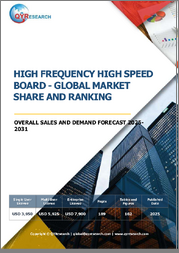
|
시장보고서
상품코드
1702046
HDI PCB 시장 보고서 : HDI 레이어별, 최종 이용 산업별, 지역별(2025-2033년)High-Density Interconnect PCB Market Report by Number of HDI Layer, End Use Industry, and Region 2025-2033 |
||||||
세계 HDI PCB 시장 규모는 2024년 91억 달러에 달했습니다. 향후 IMARC Group은 2033년에는 139억 달러에 달하고, 2025-2033년 연평균 성장률(CAGR)은 4.59%를 보일 것으로 전망하고 있습니다. 이 시장은 소형화, 고성능 전자기기에 대한 수요 증가로 인해 괄목할 만한 성장을 보이고 있습니다. 소형화, 전기적 성능 향상, 다층 구조 등의 특징으로 인해 HDI PCB는 스마트폰, 자동차, 의료기기에 필수적인 요소로 자리 잡고 있습니다. 소형화 및 고속 데이터 처리의 기술 혁신도 시장 성장에 긍정적으로 기여하고 있습니다.
HDI PCB는 기존 회로 기판보다 단위당 배선 밀도가 높은 회로 기판입니다. 블라인드 비아 및 매립 비아를 통해 기존 회로 기판보다 높은 회로 밀도를 가지면서도 기존 회로 기판보다 직경이 작고 패드 밀도가 상대적으로 높은 마이크로 비아를 포함하고 있습니다. 고밀도 PCB 기술을 통해 엔지니어는 설계의 자유와 유연성이 향상되어 부품을 더 작고 더 가깝게 배치하여 신호 손실과 교차 지연을 줄일 수 있습니다. HDI PCB는 설계자가 작업할 수 있는 표면적을 증가시킵니다. 결과적으로 HDI PCB는 더 나은 신호 품질과 고속 신호 전송을 제공합니다.
HDI PCB 시장 동향 :
세계 시장은 주로 통신, 가전, 자동차 등 다양한 최종 사용 산업에서 제품 수요 증가에 의해 주도되고 있습니다. 이는 터치스크린 장치, 휴대폰, 노트북 컴퓨터, 디지털 카메라 등 다양한 전자기기에서 제품 활용이 빠르게 진행되고 있기 때문입니다. 이와 더불어 전자기기의 소형화 추세와 고성능 가젯에 대한 수요 증가도 시장 성장에 박차를 가하고 있습니다. 이 외에도 의료비 확대에 따른 의료기기 및 장치의 도입이 진행되고 있는 것도 시장 전망을 밝게 하고 있습니다. 또한, 항공기 전자 부품 및 부품의 생산률이 상승하고 있는 것도 시장 성장을 가속하는 중요한 요인으로 작용하고 있습니다. 기타 시장 성장 요인으로는 첨단 안전 시스템의 보급, 자율 주행 트렌드 증가, 스마트 기기 및 게임기 판매 확대, 가처분 소득 수준 증가, 광범위한 연구개발 활동 등이 있습니다.
본 보고서에서 다룬 주요 질문
- 2024년 세계의 HDI PCB 시장 규모는?
- 2025-2033년 세계의 HDI PCB 시장 성장률 전망은?
- 세계의 HDI PCB 시장을 주도하는 주요 요인은?
- 코로나19가 세계의 HDI PCB 시장에 미치는 영향은?
- 세계의 HDI PCB 시장에서 HDI 레이어 수는?
- 세계의 HDI PCB 시장에서의 최종 사용 산업별 분류는?
- 세계의 HDI PCB 시장에서 주요 지역은?
- 세계의 HDI PCB 시장에서 주요 기업은?
목차
제1장 서문
제2장 조사 범위와 조사 방법
- 조사 목적
- 이해관계자
- 데이터 소스
- 1차 정보
- 2차 정보
- 시장 추정
- 보텀업 접근
- 톱다운 접근
- 조사 방법
제3장 주요 요약
제4장 서론
- 개요
- 주요 업계 동향
제5장 세계의 HDI PCB 시장
- 시장 개요
- 시장 실적
- COVID-19의 영향
- 시장 예측
제6장 시장 분석 : HDI 레이어별
- 4-6 Layers HDI PCB
- 8-10 Layers HDI PCB
- 10Layers 이상 HDI PCB
제7장 시장 분석 : 최종 이용 산업별
- 스마트폰 및 태블릿
- 컴퓨터
- 통신 및 데이터 통신
- 가전
- 자동차
- 기타
제8장 시장 분석 : 지역별
- 북미
- 미국
- 캐나다
- 아시아태평양
- 중국
- 일본
- 인도
- 한국
- 호주
- 인도네시아
- 기타
- 유럽
- 독일
- 프랑스
- 영국
- 이탈리아
- 스페인
- 러시아
- 기타
- 라틴아메리카
- 브라질
- 멕시코
- 기타
- 중동 및 아프리카
- 시장 내역 : 국가별
제9장 SWOT 분석
- 개요
- 강점
- 약점
- 기회
- 위협
제10장 밸류체인 분석
제11장 Porter의 Five Forces 분석
- 개요
- 바이어의 교섭력
- 공급 기업의 교섭력
- 경쟁 정도
- 신규 진출업체의 위협
- 대체품의 위협
제12장 가격 분석
제13장 경쟁 구도
- 시장 구조
- 주요 기업
- 주요 기업 개요
- AT & S Austria Technologie & Systemtechnik Aktiengesellschaft
- Bittele Electronics Inc.
- Fineline Ltd.
- Meiko Electronics Co. Ltd.
- Millennium Circuits Limited
- Mistral Solutions Pvt. Ltd.
- Shenzhen Kinwong Electronic Co. Ltd.
- Sierra Circuits
- TTM Technologies Inc.
- Unimicron Technology Corporation(United Microelectronics Corporation)
- Unitech Printed Circuit Board Corp.
- Wurth Elektronik GmbH & Co. KG
The global high-density interconnect (HDI) PCB market size reached USD 9.1 Billion in 2024. Looking forward, IMARC Group expects the market to reach USD 13.9 Billion by 2033, exhibiting a growth rate (CAGR) of 4.59% during 2025-2033. The market is experiencing significant growth due to the rising demand for compact, high-performance electronics. Features like reduced size, enhanced electrical performance, and multi-layered structures make HDI PCBs crucial for smartphones, automotive, and medical devices. The innovations in miniaturization and high-speed data processing, is also contributing positively to the market growth.
Interconnecting printed circuit boards (PCBs) with high-density interconnects (HDIs) are circuit boards having a better wiring density per unit than conventional circuit boards. With blind and buried vias, it contains micro-vias that are smaller in diameter and have a relatively greater pad density than conventional circuit boards while having a higher circuitry density than traditional counterparts. High-density PCB technology has allowed engineers an enhanced design freedom and flexibility, thus allowing them to place smaller and closer components, which reduces signal loss and crossing delays. An interconnect PCB with high density gives designers more surface area to work with. As a result, high-density interconnect PCBs deliver better signal quality and faster signal transmission.
High-Density Interconnect (HDI) PCB Market Trends:
The global market is primarily driven by the escalating product demand in numerous end-use industries, including telecommunication, consumer electronics, and automotive. This can be attributed to the rapid product utilization in various electronic devices like touch-screen devices, mobile phones, laptop computers, and digital cameras. In addition to this, the rising trend of electronic device miniaturization and the increasing demand for high-performance gadgets are also providing an impetus to the market. Besides this, the expanding medical expenditure resulting in a higher uptake of medical devices and equipment is also creating a positive outlook for the market. Furthermore, the augmenting production rates of electronic aircraft parts and components are acting as a significant growth-inducing factor for the market. Some of the other factors contributing to the market growth include the widespread adoption of sophisticated safety systems, the rising trend of autonomous driving, escalating sales of smart devices and gaming consoles, inflating disposable income levels and extensive research and development (R&D) activities.
Key Market Segmentation:
Breakup by Number of HDI Layer:
- 4-6 Layers HDI PCBs
- 8-10 Layer HDI PCBs
- 10+ Layer HDI PCBs
Breakup by End Use Industry:
- Smartphones and Tablets
- Computers
- Telecom/Datacom
- Consumer Electronics
- Automotive
- Others
Breakup by Region:
- North America
- United States
- Canada
- Asia-Pacific
- China
- Japan
- India
- South Korea
- Australia
- Indonesia
- Others
- Europe
- Germany
- France
- United Kingdom
- Italy
- Spain
- Russia
- Others
- Latin America
- Brazil
- Mexico
- Others
- Middle East and Africa
Competitive Landscape:
The competitive landscape of the industry has also been examined along with the profiles of the key players being AT & S Austria Technologie & Systemtechnik Aktiengesellschaft, Bittele Electronics Inc., Fineline Ltd., Meiko Electronics Co. Ltd., Millennium Circuits Limited, Mistral Solutions Pvt. Ltd., Shenzhen Kinwong Electronic Co. Ltd., Sierra Circuits, TTM Technologies Inc., Unimicron Technology Corporation (United Microelectronics Corporation), Unitech Printed Circuit Board Corp. and Wurth Elektronik GmbH & Co. KG.
Key Questions Answered in This Report
- 1.What was the size of the global High-Density Interconnect (HDI) PCB market in 2024?
- 2.What is the expected growth rate of the global High-Density Interconnect (HDI) PCB market during 2025-2033?
- 3.What are the key factors driving the global High-Density Interconnect (HDI) PCB market?
- 4.What has been the impact of COVID-19 on the global High-Density Interconnect (HDI) PCB market?
- 5.What is the breakup of the global High-Density Interconnect (HDI) PCB market based on the number of HDI layer?
- 6.What is the breakup of the global High-Density Interconnect (HDI) PCB market based on the end use industry?
- 7.What are the key regions in the global High-Density Interconnect (HDI) PCB market?
- 8.Who are the key players/companies in the global High-Density Interconnect (HDI) PCB market?
Table of Contents
1 Preface
2 Scope and Methodology
- 2.1 Objectives of the Study
- 2.2 Stakeholders
- 2.3 Data Sources
- 2.3.1 Primary Sources
- 2.3.2 Secondary Sources
- 2.4 Market Estimation
- 2.4.1 Bottom-Up Approach
- 2.4.2 Top-Down Approach
- 2.5 Forecasting Methodology
3 Executive Summary
4 Introduction
- 4.1 Overview
- 4.2 Key Industry Trends
5 Global High-Density Interconnect (HDI) PCB Market
- 5.1 Market Overview
- 5.2 Market Performance
- 5.3 Impact of COVID-19
- 5.4 Market Forecast
6 Market Breakup by Number of HDI Layer
- 6.1 4-6 Layers HDI PCBs
- 6.1.1 Market Trends
- 6.1.2 Market Forecast
- 6.2 8-10 Layer HDI PCBs
- 6.2.1 Market Trends
- 6.2.2 Market Forecast
- 6.3 10+ Layer HDI PCBs
- 6.3.1 Market Trends
- 6.3.2 Market Forecast
7 Market Breakup by End Use Industry
- 7.1 Smartphones and Tablets
- 7.1.1 Market Trends
- 7.1.2 Market Forecast
- 7.2 Computers
- 7.2.1 Market Trends
- 7.2.2 Market Forecast
- 7.3 Telecom/Datacom
- 7.3.1 Market Trends
- 7.3.2 Market Forecast
- 7.4 Consumer Electronics
- 7.4.1 Market Trends
- 7.4.2 Market Forecast
- 7.5 Automotive
- 7.5.1 Market Trends
- 7.5.2 Market Forecast
- 7.6 Others
- 7.6.1 Market Trends
- 7.6.2 Market Forecast
8 Market Breakup by Region
- 8.1 North America
- 8.1.1 United States
- 8.1.1.1 Market Trends
- 8.1.1.2 Market Forecast
- 8.1.2 Canada
- 8.1.2.1 Market Trends
- 8.1.2.2 Market Forecast
- 8.1.1 United States
- 8.2 Asia-Pacific
- 8.2.1 China
- 8.2.1.1 Market Trends
- 8.2.1.2 Market Forecast
- 8.2.2 Japan
- 8.2.2.1 Market Trends
- 8.2.2.2 Market Forecast
- 8.2.3 India
- 8.2.3.1 Market Trends
- 8.2.3.2 Market Forecast
- 8.2.4 South Korea
- 8.2.4.1 Market Trends
- 8.2.4.2 Market Forecast
- 8.2.5 Australia
- 8.2.5.1 Market Trends
- 8.2.5.2 Market Forecast
- 8.2.6 Indonesia
- 8.2.6.1 Market Trends
- 8.2.6.2 Market Forecast
- 8.2.7 Others
- 8.2.7.1 Market Trends
- 8.2.7.2 Market Forecast
- 8.2.1 China
- 8.3 Europe
- 8.3.1 Germany
- 8.3.1.1 Market Trends
- 8.3.1.2 Market Forecast
- 8.3.2 France
- 8.3.2.1 Market Trends
- 8.3.2.2 Market Forecast
- 8.3.3 United Kingdom
- 8.3.3.1 Market Trends
- 8.3.3.2 Market Forecast
- 8.3.4 Italy
- 8.3.4.1 Market Trends
- 8.3.4.2 Market Forecast
- 8.3.5 Spain
- 8.3.5.1 Market Trends
- 8.3.5.2 Market Forecast
- 8.3.6 Russia
- 8.3.6.1 Market Trends
- 8.3.6.2 Market Forecast
- 8.3.7 Others
- 8.3.7.1 Market Trends
- 8.3.7.2 Market Forecast
- 8.3.1 Germany
- 8.4 Latin America
- 8.4.1 Brazil
- 8.4.1.1 Market Trends
- 8.4.1.2 Market Forecast
- 8.4.2 Mexico
- 8.4.2.1 Market Trends
- 8.4.2.2 Market Forecast
- 8.4.3 Others
- 8.4.3.1 Market Trends
- 8.4.3.2 Market Forecast
- 8.4.1 Brazil
- 8.5 Middle East and Africa
- 8.5.1 Market Trends
- 8.5.2 Market Breakup by Country
- 8.5.3 Market Forecast
9 SWOT Analysis
- 9.1 Overview
- 9.2 Strengths
- 9.3 Weaknesses
- 9.4 Opportunities
- 9.5 Threats
10 Value Chain Analysis
11 Porters Five Forces Analysis
- 11.1 Overview
- 11.2 Bargaining Power of Buyers
- 11.3 Bargaining Power of Suppliers
- 11.4 Degree of Competition
- 11.5 Threat of New Entrants
- 11.6 Threat of Substitutes
12 Price Analysis
13 Competitive Landscape
- 13.1 Market Structure
- 13.2 Key Players
- 13.3 Profiles of Key Players
- 13.3.1 AT & S Austria Technologie & Systemtechnik Aktiengesellschaft
- 13.3.1.1 Company Overview
- 13.3.1.2 Product Portfolio
- 13.3.1.3 Financials
- 13.3.2 Bittele Electronics Inc.
- 13.3.2.1 Company Overview
- 13.3.2.2 Product Portfolio
- 13.3.3 Fineline Ltd.
- 13.3.3.1 Company Overview
- 13.3.3.2 Product Portfolio
- 13.3.4 Meiko Electronics Co. Ltd.
- 13.3.4.1 Company Overview
- 13.3.4.2 Product Portfolio
- 13.3.4.3 Financials
- 13.3.5 Millennium Circuits Limited
- 13.3.5.1 Company Overview
- 13.3.5.2 Product Portfolio
- 13.3.6 Mistral Solutions Pvt. Ltd.
- 13.3.6.1 Company Overview
- 13.3.6.2 Product Portfolio
- 13.3.7 Shenzhen Kinwong Electronic Co. Ltd.
- 13.3.7.1 Company Overview
- 13.3.7.2 Product Portfolio
- 13.3.7.3 Financials
- 13.3.8 Sierra Circuits
- 13.3.8.1 Company Overview
- 13.3.8.2 Product Portfolio
- 13.3.9 TTM Technologies Inc.
- 13.3.9.1 Company Overview
- 13.3.9.2 Product Portfolio
- 13.3.9.3 Financials
- 13.3.9.4 SWOT Analysis
- 13.3.10 Unimicron Technology Corporation (United Microelectronics Corporation)
- 13.3.10.1 Company Overview
- 13.3.10.2 Product Portfolio
- 13.3.10.3 Financials
- 13.3.11 Unitech Printed Circuit Board Corp.
- 13.3.11.1 Company Overview
- 13.3.11.2 Product Portfolio
- 13.3.11.3 Financials
- 13.3.12 Wurth Elektronik GmbH & Co. KG
- 13.3.12.1 Company Overview
- 13.3.12.2 Product Portfolio
- 13.3.1 AT & S Austria Technologie & Systemtechnik Aktiengesellschaft



















